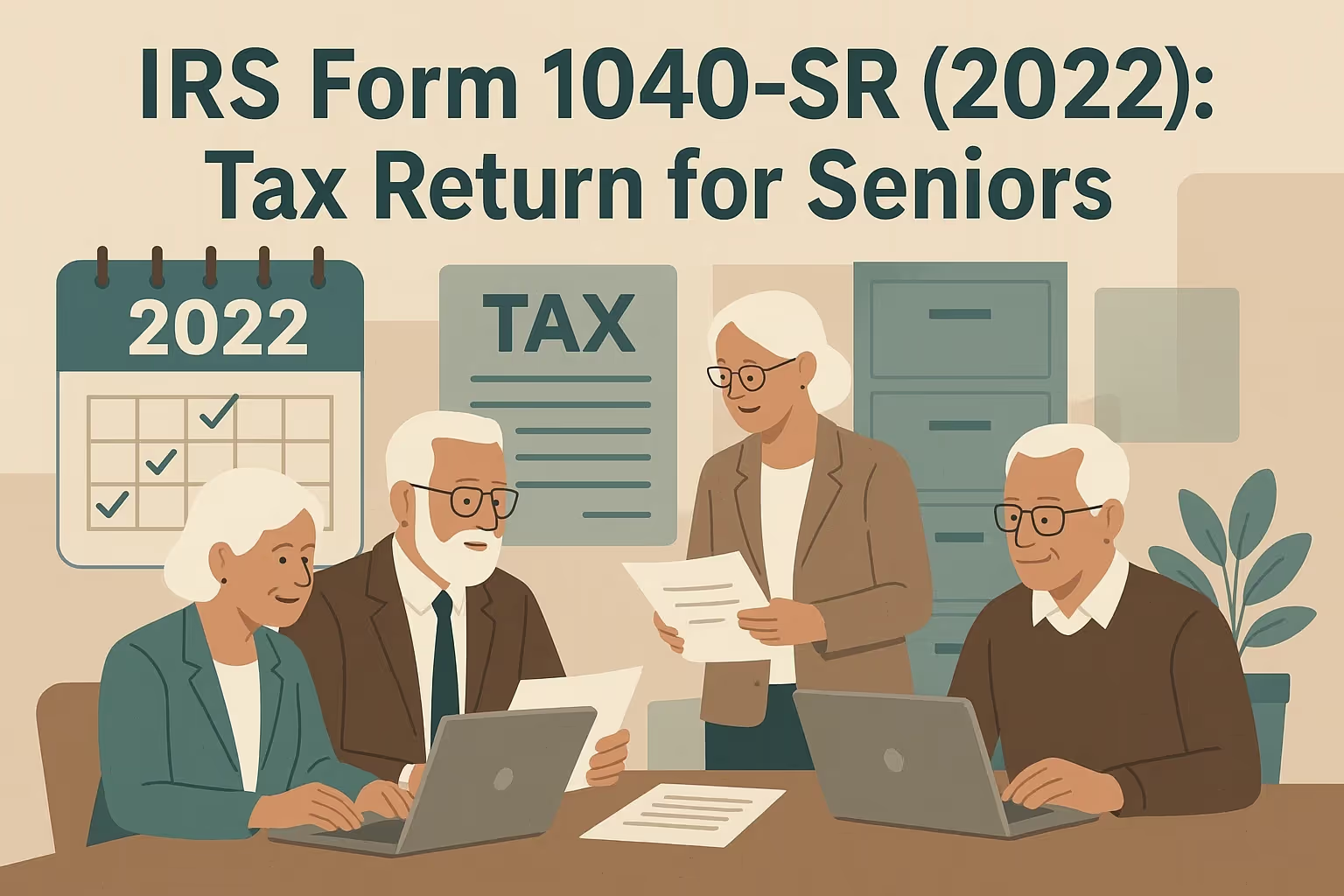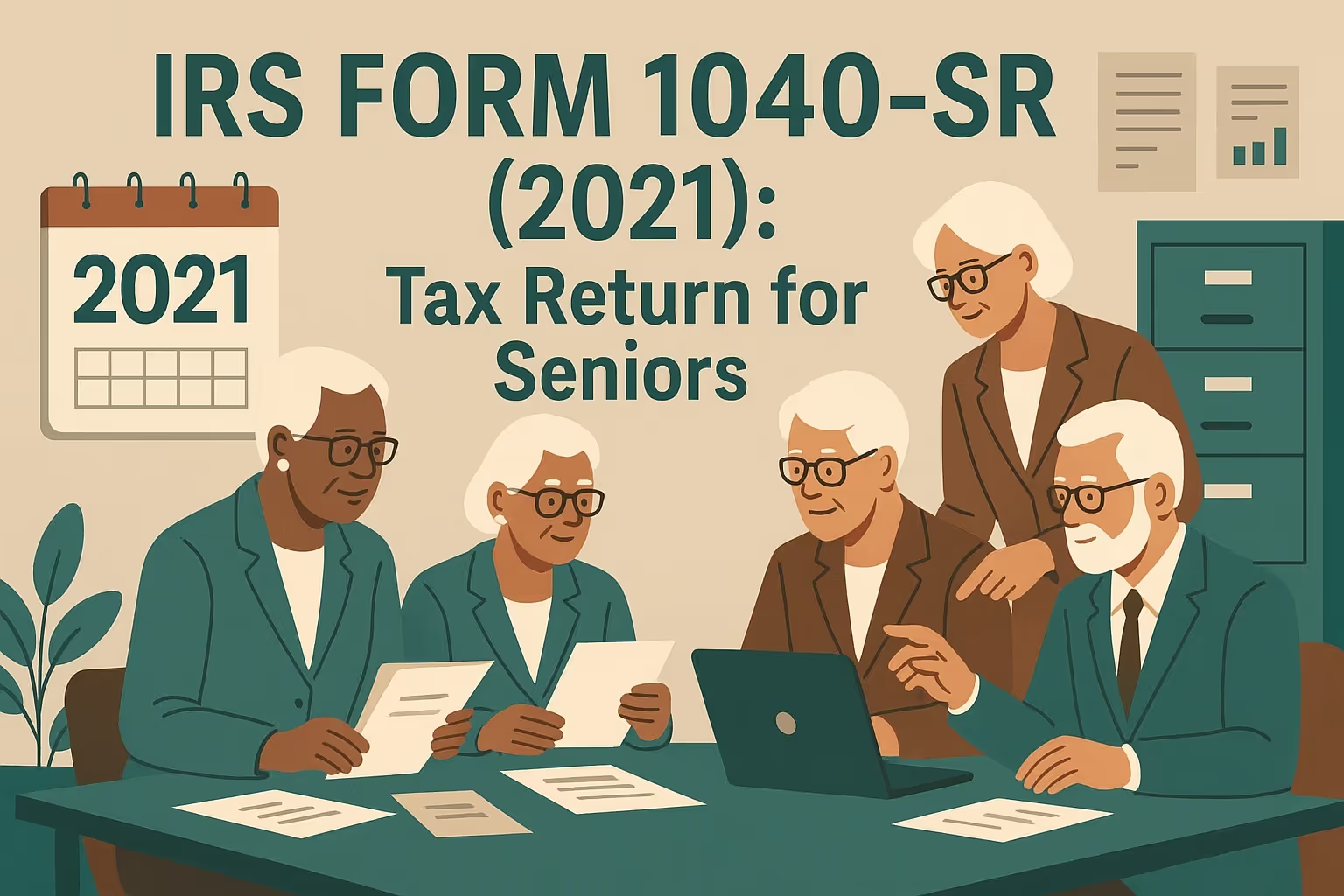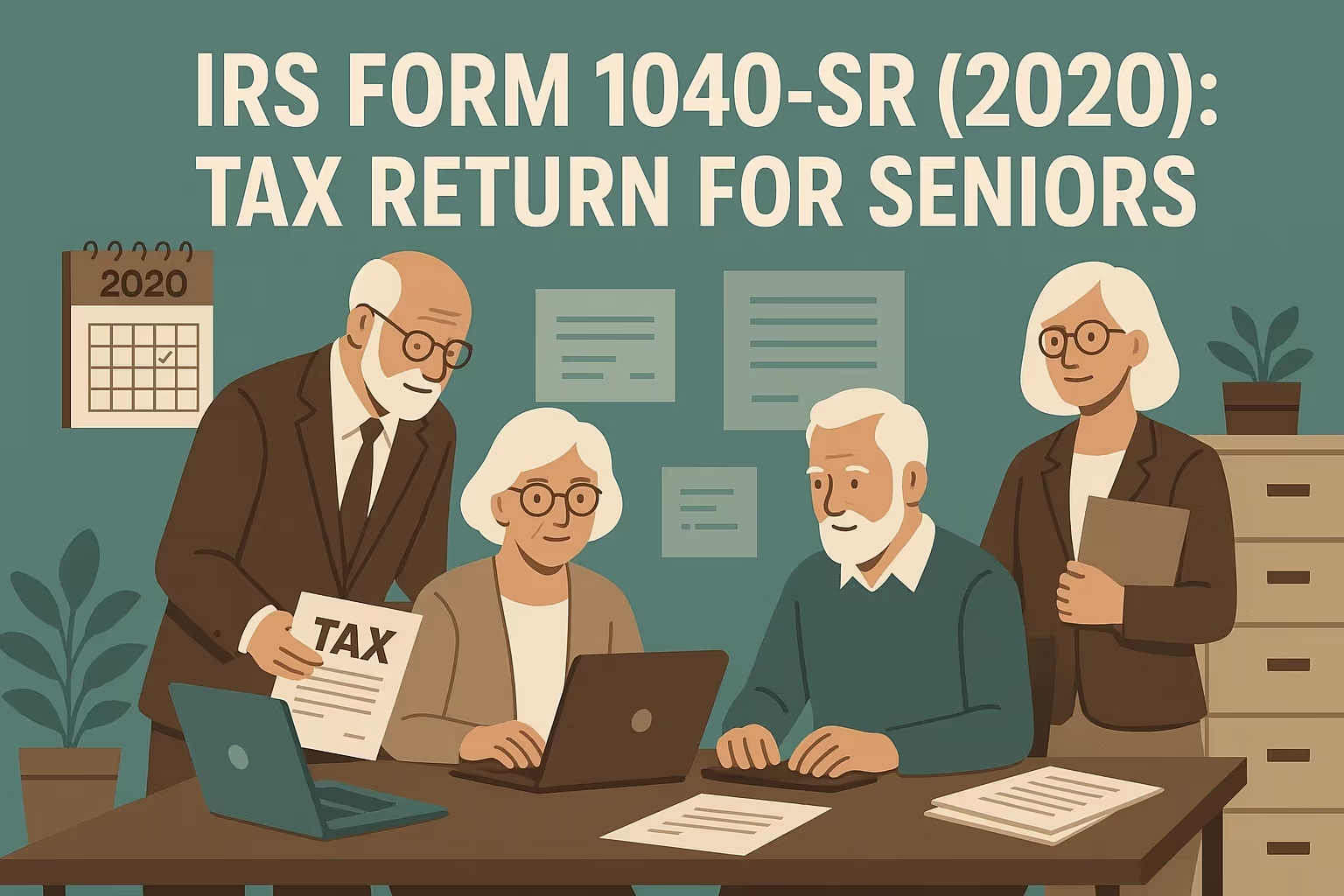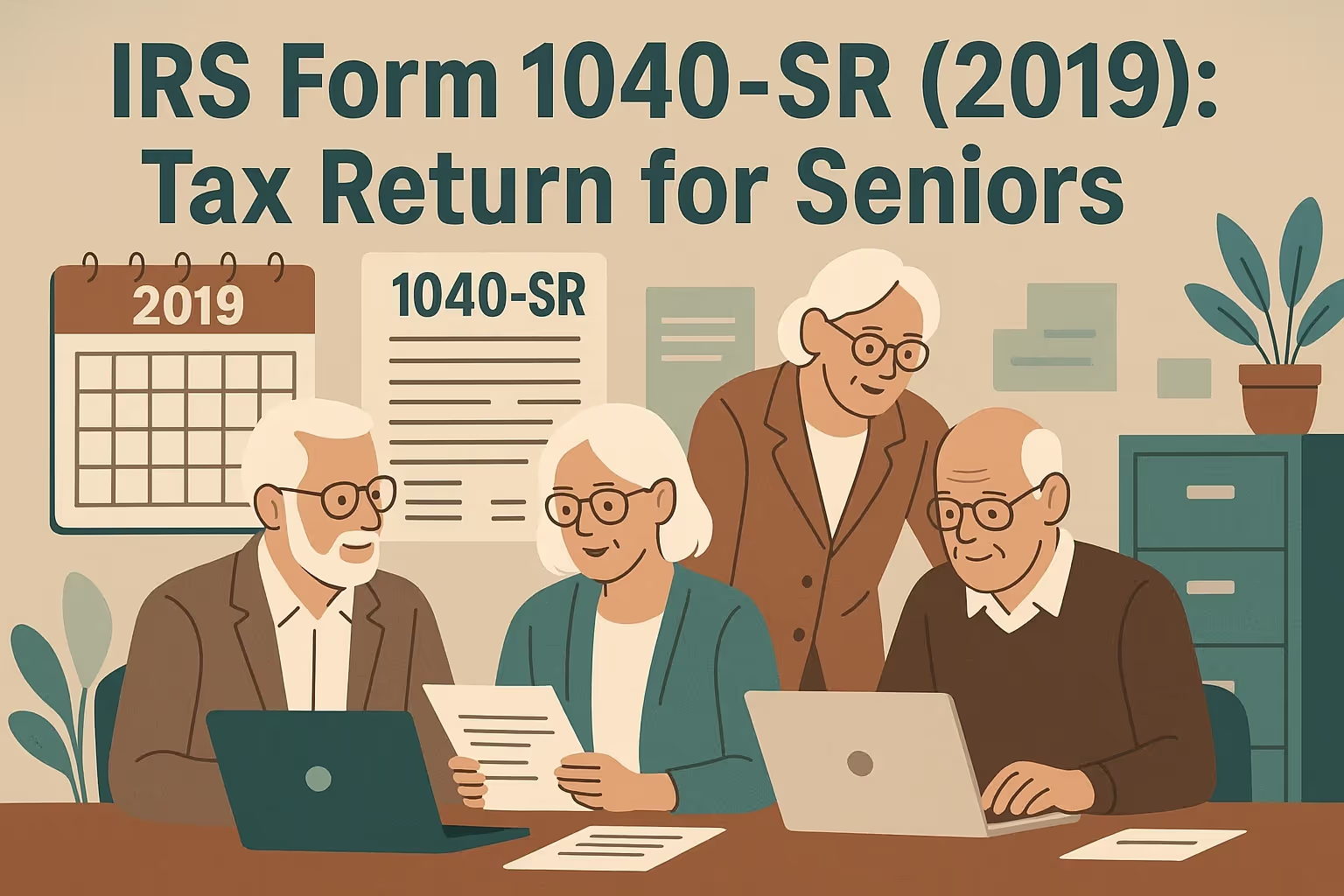Form 1040SR 2016 Instructions: Complete Guide for Seniors
Filing a tax return for the 2016 tax year required seniors to use the same individual income tax return forms as all taxpayers. Form 1040SR did not exist, so the Internal Revenue Service directed seniors to Form 1040, Form 1040A, or Form 1040EZ. Choosing the correct tax form based on taxable income, filing status, and deductions ensured accuracy, compliance with federal law, and protection against penalties.
Many seniors reported wages, pensions, Social Security, or student loan interest, while others accounted for self-employment tax, withholding, and estimated tax payments. Reliable e-filing software and paper forms supported taxpayers in preparing prior-year forms, claiming credits such as the earned income tax credit or child tax credit, and completing schedules for deductions and other forms. Using trusted tax code instructions reduced errors and helped households manage personal finances effectively.
This guide provides clear instructions for completing a 2016 federal individual income tax return. Seniors will find examples covering filing jointly, married filing separately, surviving spouse rules, and household situations. The information also explains how to pay taxes, deduct expenses, use extensions, and apply additional forms when required. Whether using TurboTax Free Edition, other software, or standard form versions, you will find the guidance to file correctly and receive a refund.
Overview of 2016 Individual Income Tax Return Forms for Seniors
Senior taxpayers chose among Form 1040EZ, Form 1040A, and Form 1040 to file a federal tax return for 2016. Each form handled income, deductions, and schedules differently, affecting accuracy and refunds. The right selection depends on income complexity and deduction strategy. The following subsections outline eligibility, restrictions, and use cases so you can decide confidently.
Form 1040EZ: Simplest income tax return option
- Eligibility requirements: Taxable income under $100,000, no dependents, and income limited to wages, tips, unemployment compensation, and small interest. Seniors fitting these constraints could select Form 1040EZ.
- Restrictions: Itemizing, including mortgage interest, was prohibited, and advanced schedules were excluded. These limits often reduce refund potential for seniors with high medical expenses.
- When appropriate: Choose Form 1040EZ only when income is simple, refund expectations are modest, and schedules are unnecessary. Seniors achieved outcomes using Form 1040A or Form 1040.
Form 1040A: Middle option for tax filing
- Income limits: Seniors could report pensions, dividends, and Social Security if their total income stayed below $100,000. This limit preserved a simpler process while supporting credits.
- Deductions allowed: Form 1040A permitted certain adjustments and nonrefundable credits. It supported limited schedules, enabling accuracy without the complexity of a full return and improving refund potential.
- When seniors use it: It fits moderate situations with pensions, interest, dividends, and straightforward deductions. Seniors not requiring Schedule A complexity often completed accurate returns using Form 1040A.
Form 1040: Comprehensive income tax return
- Income reporting: Required when taxable income exceeds $100,000 or income includes investments, pensions, and taxable Social Security. The form supported complete reporting for accuracy and compliance.
- Deductions flexibility: Allowed full itemizing, including mortgage interest, medical expenses, charitable giving, and state taxes. This flexibility often increases refund potential for seniors with higher healthcare spending.
- Best for seniors: Best for complex finances requiring multiple schedules. It covered capital gains, retirement distributions, and detailed adjustments, helping seniors file accurately and pursue a maximum refund.
Senior-specific benefits to reduce federal taxes
- Higher filing threshold: Seniors could earn more before filing, reducing tax filing for low-income individuals. Thresholds increased across statuses, lowering administrative burdens and limiting compliance risk.
- Higher standard deduction: Additional amounts apply for people age sixty-five and older, increasing the standard deduction. Automatic deductions improve refunds or reduce balances due for retirees with limited itemizing.
- Medical expense deduction: Medical expenses over 7.5 percent of adjusted gross income were deductible, improving the itemizing value for seniors with costs from premiums, treatments, or long-term care.
- Elderly or disabled credit: Eligible seniors could claim the credit for the elderly or disabled, up to $1,125. This nonrefundable credit reduced federal taxes owed when income met limits.
What Is New for the 2016 Federal Tax Return
Several changes affected the 2016 federal tax return for seniors. Standard deduction add-ons increased, filing thresholds shifted, and certain exemptions and credits were updated. Social Security taxation rules remained unchanged. Understanding these updates improves accuracy and reduces penalties. The following subsections highlight the amounts and definitions that mattered most during the 2017 filing season.
2016 standard deduction amounts and senior add-ons
- Single: $6,300 standard deduction plus $1,550 senior addition equals $7,850. This higher amount reduced taxable income automatically for qualifying seniors.
- Married filing jointly: $12,600 standard deduction plus $1,250 per spouse age sixty-five or older; $15,100 when both are qualified, lowering taxable income meaningfully.
- Head of household: $9,300 standard deduction plus $1,550 senior addition equals $10,850. The increased amount provided automatic relief without itemizing deductions.
2016 filing threshold increases for age 65+
- Single seniors: Filing is required once gross income exceeds $11,900 for the year. The increase avoids unnecessary returns for very low incomes.
- Married, one spouse 65+: Filing required at $21,950. The threshold recognized added relief while capturing returns where tax liability likely existed.
- Married, both 65+: Filing required at $23,200. The change reduced filing for very low incomes and prioritized returns with measurable liability.
Other notable 2016 updates
- Personal exemption: Increased to $4,050 per person, shielding more income from taxation and slightly improving refund outcomes across filing statuses.
- Earned Income Credit: Maximums increased for all categories, though many retirees did not qualify. Amounts still helped certain senior workers with modest wages.
- Alternative Minimum Tax: Exemption amounts rose, reducing exposure for some households. Seniors with investment income benefited when calculations shifted below prior-year thresholds.
- Social Security taxation: The inclusion rules remained unchanged. Seniors continued calculating taxable benefits using worksheets in the Instructions for Form 1040.
The age test for those 65 or older in 2016
Taxpayers were considered age sixty-five for 2016 if they turned sixty-five on or before January 1, 2017. A birthdate of January 1, 1952, qualifies. This definition mattered for higher standard deductions and filing thresholds. Confirm your birthdate on identification documents and acknowledge the age checkbox on the return to ensure correct calculations and eligibility.
Step-by-Step Instructions to File Your Taxes
Follow a structured process to prepare, file, and pay your 2016 federal taxes. Each step focuses on information gathering, correct forms, and complete reporting for a dependable refund or balanced outcome.
Step 1: Gather your tax documents
Collect Form W-2 from each employer, Form 1099-R for pensions, Form SSA-1099 for Social Security, and Forms 1099-INT and 1099-DIV for interest and dividends. Include mortgage interest statements, property tax bills, and medical receipts. Organize everything by source and year. Upload digital copies to secure software and keep paper originals in a labeled home folder.
Step 2: Choose the correct form
Match your situation to Form 1040EZ, Form 1040A, or Form 1040. Simple wages and limited interest may qualify for 1040EZ. Moderate retirement income suits 1040A. Complex income, itemizing, or higher totals require Form 1040. When uncertain, read the instructions or contact a tax expert for guidance to protect accuracy and avoid penalties.
Step 3: Complete personal information
Enter full legal names, Social Security numbers, and addresses exactly as records show. Select the correct filing status. Mark the age sixty-five checkbox for each qualifying person to secure the higher standard deduction. Confirm dependent information if applicable. Ensure the preparer section is complete when using expert help, and keep email and phone details current for IRS questions.
Step 4: Report your income
Record wages, interest, dividends, pensions, annuities, and any taxable Social Security. Verify amounts against forms received, ensuring totals match precisely. Use schedules when required, and include retirement distributions accurately. If receiving state refunds or taxable settlements, enter those amounts. Read the instructions carefully in unclear situations or seek expert help to maintain accuracy.
Step 5: Calculate adjusted gross income
Subtract eligible adjustments, including IRA contributions, HSA deductions, and any allowable educator or self-employment adjustments. Confirm each entry in the software reflects documented amounts. Accurate AGI drives credit eligibility and limits. Keep worksheets with your tax return for reference. If figures appear inconsistent, stop and investigate before making deductions or payment decisions.
Step 6: Select standard or itemized deductions
Compare your standard deduction with itemized deductions for mortgage interest, state taxes, medical expenses, and charitable giving. Choose the larger path to reduce taxable income and strengthen refund potential. If itemizing, gather documentation and complete Schedule A carefully. Enter totals directly into software, confirm subtotals, and review calculation notes for accuracy.
How to File Your Taxes
In 2016, seniors could choose between electronic filing and mailing paper returns. Filing taxes online offered faster refunds, fewer errors, and easier acknowledgment. Paper filing remained available for those preferring traditional methods. Both approaches required accuracy, signing, and complete schedules.
Why e-filing helps seniors
- Faster refunds: Refunds typically arrive within twenty-one days, compared to six to eight weeks with paper returns. Seniors benefited from quicker access to money.
- Higher accuracy: Software checked calculations automatically, reducing mistakes and penalties. Seniors avoided interest charges by filing correctly the first time.
- Immediate confirmation: Returns submitted electronically generate acknowledgment receipts directly from the IRS, giving seniors confidence that their federal tax return was received.
Free filing help available
- IRS Free File: Offered free software for taxpayers with adjusted gross income under $62,000, including options for both federal and some state returns.
- Volunteer Income Tax Assistance: Provided free preparation for those below $54,000. Trained volunteers helped seniors complete forms, answer questions, and file securely.
- Tax Counseling for the Elderly: This service provides targeted guidance to seniors sixty and older, focusing on deductions, credits, and accuracy when filing their income tax returns.
- AARP Tax-Aide: Supplied free expert help for seniors with moderate incomes. Volunteers prepared returns, provided guidance, and sent completed returns directly to the IRS.
Paper filing process
- When to choose: Paper is rare and suitable for seniors without reliable devices or those who prefer paper documents. It offers familiarity but requires more steps. The steps are to download forms from IRS.gov, complete schedules by hand, sign carefully, and send the return by certified mail. Always include supporting documents.
- Risks: Paper return errors, slower refunds, and lost mail. Seniors often need expert help to ensure accuracy before mailing.
2016 filing deadline reminder
The filing deadline for 2016 returns was April 18, 2017, the Emancipation Day holiday in Washington, D.C., providing additional time to complete and send the returns.
Payment Instructions
Suppose you owed federal taxes on your 2016 income tax return. Options included secure online systems, credit or debit cards, and traditional check or money order. Seniors could also request payment plans. Understanding these services ensured seniors could pay on time, avoid penalties, and manage taxes responsibly without overcomplicating the process.
Electronic payment options
- Direct Pay: Free IRS service allowing payment from a bank account with instant confirmation. Seniors used it for convenience, security, and accuracy when paying.
- EFTPS: The Electronic Federal Tax Payment System allows scheduled payments and payment review. Seniors with recurring obligations find it reliable for federal tax return payments.
- Credit or debit card: Seniors could pay through IRS-approved processors. Fees applied, but cards provided flexibility. Confirmation was immediate, and payments counted as timely.
Traditional payment methods
- Check or money order: Payable to the United States Treasury, mailed with Form 1040V. Seniors needed to write their Social Security numbers and tax year clearly.
- Cash pay: This type of payment is accepted at IRS retail partners. Taxpayers may pay up to $1,000 daily or $5,000 annually. Receipts are provided immediately.
Payment plans for taxpayers
- Short-term payment plan: Allowed up to 120 days for balances under $100,000. No setup fee was applied, though penalties and interest continued accruing.
- Long-term installment agreement: Monthly payments exceeded 120 days. Setup fees varied but were reduced for low-income taxpayers. Agreements prevented enforced collection and allowed flexible repayment.
Why file even if you cannot pay
Filing on time prevented failure-to-file penalties, which were higher than failure-to-pay charges. Seniors protected themselves by filing complete returns promptly, even when they could not pay immediately.
Required Schedules and Attachments
Completing a 2016 federal tax return sometimes required attaching schedules or extra forms. Seniors with itemized deductions, capital gains, or specific income sources needed additional documents. Using the right schedules ensured accuracy, protected refunds, and avoided questions from the IRS. The subsections below highlight the schedules seniors most often filed and why each mattered.
Schedule A: Itemized deductions for seniors.
- Medical expenses: Deductible above 7.5 percent of adjusted gross income for seniors. Records included premiums, treatments, prescriptions, and long-term care.
- Mortgage interest: Interest on qualifying home loans reduces taxable income. Seniors claiming this deduction needed an accurate Form 1098 from lenders for documentation.
- Charitable contributions: Cash and property donations require receipts. Seniors often increase refund opportunities by recording eligible charitable giving accurately.
- Taxes paid: State and local taxes could be deducted. Including these amounts reduced taxable income, though the totals required careful calculation and acknowledgment.
Schedule B: Reporting interest and dividends
- This requirement applies to dividend income exceeding $1,500 or including foreign accounts. Seniors often trigger this requirement due to investments.
- Details included: Listed payers, amounts received, and account details. Accuracy was maintained since the IRS received documents directly from financial institutions.
- Why it is important: Reporting interest and dividends prevented penalties, and IRS income mismatches did not delay refund processing.
Schedule D: Capital gains and losses
- Purpose: To report sales of investments such as stocks and bonds. Seniors selling assets during 2016 often needed this schedule for accuracy.
- Carryovers: Included prior-year capital loss carryovers, affecting 2016 calculations. Seniors with investment activity required this schedule to complete their return.
Schedule R: Credit for older people or the disabled
- Eligibility: Available to seniors sixty-five and older or retired individuals with permanent disabilities. Income limits applied, affecting who could qualify.
- Benefit: Offered up to $1,125 in credit, directly lowering tax liability. Eligible seniors reduced their balance due to increased refund amounts.
Senior-specific forms
- Form 8606: Required for nondeductible IRA contributions or distributions. Seniors risked a $50 penalty for failing to complete it accurately.
- Form 8889: Needed for Health Savings Accounts. Seniors with high-deductible plans used it to track contributions, withdrawals, and taxable amounts.
Attachment checklist for accuracy
- Attach all forms: Ensure all schedules and supporting forms are included.
- Check signatures: Verify that the taxpayer and preparer sections are signed.
- Keep copies: Seniors needed paper and digital copies for future reference, audits, or state filings.
Common Mistakes to Avoid
Mistakes slowed refunds, triggered penalties, and created unnecessary IRS contact. Seniors filing 2016 federal taxes often repeated similar errors. Careful preparation, reading instructions, and using reliable software reduced risks. Each subsection below explains where problems commonly occur and how to avoid them—seniors who reviewed documents before signing improved accuracy and protected their money.
Personal information errors
- Social Security numbers: Seniors often misenter digits. Double-check against Social Security cards before filing to prevent refund delays.
- Names and filing status: Use full legal names and correct filing status. Incorrect entries caused mismatched records and processing issues.
- Age checkbox: Failing to mark the age sixty-five box reduced deductions. Seniors needed to acknowledge this section clearly for the correct totals.
Income reporting errors
- Missing forms: Seniors forgot to include certain 1099s. Every employer, bank, or payer also issues forms that the IRS receives directly.
- Social Security: Some seniors assumed benefits were untaxed. Correct reporting required worksheets. Errors led to IRS questions and penalties.
- Pension reporting: Gross and taxable amounts were confused. Using instructions or software ensured that seniors calculated taxable income accurately.
Deduction mistakes
- Medical threshold: Seniors sometimes applied a 10 percent threshold instead of 7.5 percent, reducing deductions unfairly. Confirm the correct threshold before filing.
- Charitable giving: Missing receipts or incorrect totals created audit risks. Always gather documentation and record amounts exactly.
- Standard versus itemized: Seniors sometimes failed to compare both. This mistake reduced potential refunds or increased amounts owed.
Math and calculation errors
- Addition and subtraction: Manual math errors delayed refunds. Using software or double-checking with calculators improved accuracy and reliability.
- Tax tables: Selecting the wrong column produced incorrect tax amounts. Seniors needed to read carefully and select the proper filing status column.
Signature and date issues
- Unsigned returns: Seniors sometimes forgot to sign. The IRS rejects unsigned federal tax returns automatically.
- Incorrect year: Some mistakenly dated returns with 2016 instead of 2017. Accurate dating confirmed acknowledgment of the correct tax year.
Zero Activity or Dormant Year Guidance
Some seniors experienced years with little or no taxable income. Filing was not always required, but important reasons existed to file anyway. Understanding filing thresholds, refund opportunities, and credit eligibility helped seniors decide. The following subsections explain when seniors need to file a federal tax return and when submitting is beneficial despite no filing requirement.
Filing requirement thresholds for seniors
- Single filer age 65+: This is required when income exceeds $11,900 to ensure seniors report sufficient compliance with the 2016 federal tax return rules.
- Married filing jointly, one 65+: Filing required when income exceeded $21,950. The threshold reflected updated limits and reduced unnecessary filings for many couples.
- Married filing jointly, both 65+: Filing required when income exceeded $23,200. This higher threshold excluded many seniors from mandatory filing during 2016.
Good reasons to file even if not required
- Refund recovery: Seniors filing even with low income claimed refunds from withheld wages, pensions, or estimated tax payments. Filing ensured no refund money was lost.
- Claiming credits: Seniors could claim refundable credits, such as the Additional Child Tax Credit or certain education credits. Filing returned money otherwise forfeited.
- Documentation: Filing created official records for income, deductions, and taxes paid. Seniors benefited from answering future IRS questions when applying for loans or benefits.
Special considerations for seniors
- Social Security: Social Security benefits alone rarely required filing, but combined income with pensions sometimes triggered obligations. Filing ensured correct reporting and avoided penalties.
- Pensions: Distributions sometimes require reporting even when under thresholds. Seniors monitored taxable portions closely and attached necessary schedules for compliance.
- Investments: Interest or dividends occasionally trigger filing. Reporting avoided issues with IRS matching programs and federal tax return processing compliance.
Why filing can still be safer
Filing even when not required generally posed no risk. Seniors who submitted accurate returns ensured refunds were not missed and credits were preserved. The filing also provided official IRS acknowledgment that income was reported, reducing future disputes. The safe approach was often to prepare and file using free file options, even for dormant years.
First-Time Senior Filer Tips
Seniors filing for the first time after turning 65 needed to adjust their approach. Age-based benefits applied, and income patterns changed. Maximizing deductions, credits, and refund opportunities helped seniors prepare effectively. The following subsections outline age determination, deduction advantages, income changes, and planning tips for future years to support smooth tax filing experiences.
Confirming senior age status for 2016
Taxpayers were considered age 65 if they turned 65 on or before January 1, 2017. Seniors qualify for higher standard deductions and filing thresholds. Confirming eligibility protected refund opportunities and ensured deductions were applied properly. When filing their federal taxes, they must accurately mark the checkbox on Form 1040 or Form 1040.
Key benefits at age 65 and older
- Higher standard deduction: Seniors automatically gain additional deduction amounts, and their working taxable income reduces liability and improves their chances of getting a refund.
- Medical expense deduction: Seniors deducted expenses above 7.5 percent of AGI, including premiums, prescriptions, and treatments. This rule provided significant relief.
- Elderly or disabled credit: Seniors with limited income qualified for the nonrefundable credit. It lowered taxes owed and often boosted refund results.
Common first-year adjustments
- Income changes: Retirement reduced wages while increasing pensions and Social Security. Seniors adjusted their reports accurately to reflect new income.
- Deduction strategies: Higher standard deductions sometimes replaced itemizing. Seniors compared both methods to maximize refund opportunities during their first filing year.
- Planning needs: Seniors monitored withholdings and estimated payments. Adjustments prevented underpayment penalties and improved cash flow during retirement years.
Planning for future years
Seniors benefited by preparing early for required minimum distributions beginning at age 70½, tracking medical expenses, and keeping organized records. Planning ensured compliance, reduced penalties, and preserved refund opportunities. Using expert help or software, seniors can file accurately, reduce mistakes, and manage tax obligations effectively in later retirement years.
Frequently Asked Questions
The following section answers seniors' common questions when filing a 2016 federal tax return. Each response is clear and directly addresses the situation with relevant details. Seniors can use these answers to improve their understanding, avoid mistakes, and file confidently. Review these questions carefully to find reliable guidance on the issues many seniors faced during the 2017 filing season.
Do I qualify as age 65 for my 2016 return if I turned 65 in early 2017?
You were considered 65 for the 2016 federal tax return only if your birthday was on or before January 1, 2017. A birthdate of January 1, 1952, qualified. This status granted higher standard deductions and adjusted filing thresholds. If you turned 65 later in 2017, benefits applied beginning with your 2017 income tax return instead.
Can seniors still use Form 1040EZ, and when is Form 1040 better?
Yes, seniors meeting eligibility rules could still file Form 1040EZ for 2016. However, Form 1040 generally provided stronger refund opportunities through itemizing deductions like mortgage interest or medical costs. Most seniors benefited from using Form 1040, since it supported all schedules, allowed complete reporting, and provided flexibility to maximize refund outcomes.
How do I report my first pension payment on my 2016 Form 1040?
Report the total pension distribution on line 16a of Form 1040. Enter the taxable portion on line 16b. Use the Simplified Method worksheet from the instructions when calculating taxable amounts. Seniors with pensions that include after-tax contributions must calculate carefully to avoid overpaying. Attach Form 1099-R with your federal tax return for documentation.
Should I itemize medical expenses or take the higher senior standard deduction?
Seniors compared itemized deductions to the increased standard deduction for those 65 and older. Itemizing proved valuable when medical expenses exceeded 7.5 percent of adjusted gross income. Other factors included mortgage interest, charitable giving, and state taxes. If itemized totals exceeded the senior standard deduction, itemizing provided a stronger refund opportunity for 2016.
What if I cannot pay my full 2016 tax by April 18, 2017?
File your income tax return on time, even if payment is impossible. Filing prevented the failure-to-file penalty, which was higher than failure-to-pay charges. Seniors could then request short-term payment extensions or installment agreements. The IRS offered flexible options to manage balances responsibly, avoid enforced collection, and reduce penalties while paying taxes over time.


















